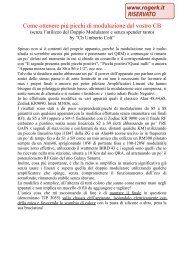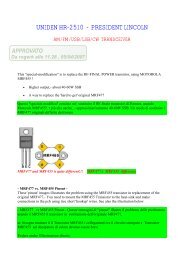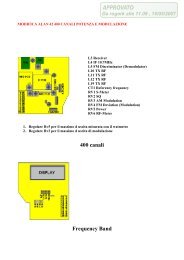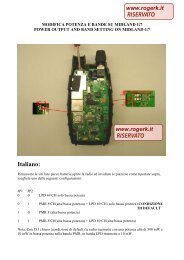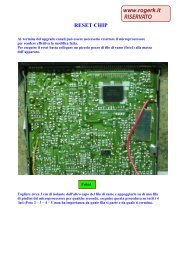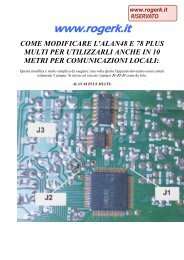Modifications for the ICOM - RogerK
Modifications for the ICOM - RogerK
Modifications for the ICOM - RogerK
- No tags were found...
You also want an ePaper? Increase the reach of your titles
YUMPU automatically turns print PDFs into web optimized ePapers that Google loves.
18-06-2000(IC-729) Using two Icom rigs in transceiveAuthor: Richard Mekka - richard@mekka.freeserve.co.uk.MODIFICATION.NETI have an IC729 and a R72 rx in <strong>the</strong> shack here, and I wanted to try some experiments with using separate aerials <strong>for</strong> receive &transmit. Getting <strong>the</strong> two pieces of equipment to "talk" to each o<strong>the</strong>r using <strong>the</strong> CI-V interface was no problem, but try as I mightI could not see a way to prevent a master-master situation i.e. turning ei<strong>the</strong>r tuning knob caused <strong>the</strong> o<strong>the</strong>r rig to follow.What I wanted was a master-slave set-up; in my case <strong>the</strong> IC729 to control <strong>the</strong> R72 but NOT <strong>the</strong> opposite. This would mean thathaving started a QSO I could use <strong>the</strong> receiver <strong>for</strong> split operation, or as a kind of RIT.Initial thoughts consisted of having a switch to break <strong>the</strong> CI-V line as and when transceive was not needed, but this wasn't veryelegant and would involve lots of switching on and off. Then I had a great idea. What common electronic device lets signals passone way but not <strong>the</strong> o<strong>the</strong>r? Correct! The good old humble diode!A quick lashup proved that my <strong>the</strong>ory was right. The 0.7 volt drop does not effect operation of <strong>the</strong> data signal in <strong>the</strong> desireddirection, which is a little surprising as <strong>the</strong> signal is only a 2 volt signal (unterminated) to begin with. Maybe <strong>the</strong> fanout isreduced with <strong>the</strong> diode fitted, but I have been unable to test this.In <strong>the</strong> end I made up a lead with <strong>the</strong> diode in series with <strong>the</strong> coax "inner", inside one of <strong>the</strong> jack plug covers Don't bo<strong>the</strong>r tryingto work out which way round to solder it: if control is <strong>the</strong> wrong way reverse <strong>the</strong> lead. It's probably worth marking <strong>the</strong> lead sothat it isn't used <strong>for</strong> audio work - might cause a few strange effects!This modification is read 542 times.top of page20-10-2001(IC-729) Modification Icom IC-729: General coverage TXOpen up <strong>the</strong> radio and locate <strong>the</strong> pll board, cut diode D5. The board should be located on <strong>the</strong> left hand side at <strong>the</strong> rear. Reset <strong>the</strong>cpu by pressing function and <strong>the</strong> mw button toge<strong>the</strong>r while turning <strong>the</strong> radio off and on again.That will give you tx coverage from 1.6 to 30MHz!This modification is read 661 times.top of page05-10-1998(IC-730) Preventative Maintenance <strong>for</strong> <strong>the</strong> <strong>ICOM</strong> IC-730Though <strong>the</strong> IC-730 is a good-per<strong>for</strong>ming, reliable radio, many of <strong>the</strong>se units have been in service <strong>for</strong> a number years and arebeginning to show <strong>the</strong>ir age. The following preventative maintenance procedures should be done to all IC-730's that come in <strong>for</strong>repair. You will find that when you take a few minutes to attend <strong>the</strong>se minor details while <strong>the</strong> radio is on your bench, your returnrepairrate <strong>for</strong> <strong>the</strong> IC-730 will be almost nil.1. On <strong>the</strong> RF unit, resolder <strong>the</strong> connectors at J2 and J3 on <strong>the</strong> RF unit. Due to <strong>the</strong> relatively thick coax cables on <strong>the</strong>connectors, <strong>the</strong>se joints tend to crack with age and cause intermittent transmit and receive problems.2. Make sure <strong>the</strong> receiver preamp works. If inoperative, replace relay RL1 on <strong>the</strong> RF unit. Install <strong>the</strong> factory update to preventrelay failure3. Check transistor Q5 on <strong>the</strong> RF unit. If it is a 2SC945Q, replace it with <strong>the</strong> improved 2SC2878B to prevent spurious outputfrom <strong>the</strong> transmitter and failure of <strong>the</strong> driver transistors. If Q5 is a type 1636, it doesn't need to be replaced.4. Clean <strong>the</strong> RIT pot and switch with tuner cleaner. These controls are usually noisy and erratic, making <strong>the</strong> RIT hard to use.5. Tighten <strong>the</strong> chrome-plated PC board mounting screws. The type of screw and spacer used in <strong>the</strong> IC-730 tends to comeloose if <strong>the</strong> radio is used in a high-vibration, mobile environment. Don't <strong>for</strong>get to tighten <strong>the</strong> screws on <strong>the</strong> logic and IFunits located beneath <strong>the</strong> main unit.6. Check <strong>the</strong> bandwidth coupler <strong>for</strong> proper tightness. Tighten as needed.




